I’m spending a couple of days in Lodz for the Photo Festival. Or rather, the Fotofestiwal. I haven’t seen all the exhibitions yet but so far, so good. I’ve been particularly fascinated by Zhao Renhui’s A Guide to the Flora and Fauna of the World which has been selected for the Grand Prix Fotofestiwal.
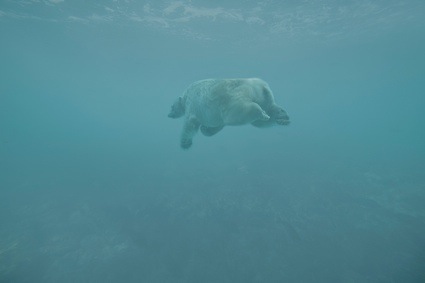 Renhui Zhao, A Guide to the Flora and Fauna of the World, Fat polar bear swimming in Hudson Bay
Renhui Zhao, A Guide to the Flora and Fauna of the World, Fat polar bear swimming in Hudson Bay
The photo series attempts to document the ways in which the human species has altered the planet, and in particular other life forms.
The result of his research is a visually stripped back catalogue of curious creatures and life-forms. Some had to evolve in order to cope with the pressures of a fast changing world. Others appeared as the results of direct human intervention, mutations engineered to serve purposes ranging from scientific research to the desire for ornamentation:
Remote-controlled coakroach, peanuts injected with the DNA of a lobster so that they will never go bad, medicinal eggs with extractable antibodies against cancer, caterpillar-killing cabbage carrying the gene responsible for producing the poison in scorpions, tomatoes that do not go bad, sugar cane engineered with human gene, the first tiger mosquito found in Norway, etc.
Zhao’s work addresses man’s relationship with nature, and related issues of morality and ethics, paying close attention to how our attitudes assumptions about the natural world are often shaped by institutions of authority and the media.
Quick selection, with comments copied/pasted from the project website:
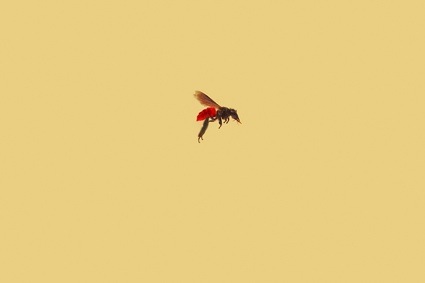 Renhui Zhao, A Guide to the Flora and Fauna of the World, Blood bee
Renhui Zhao, A Guide to the Flora and Fauna of the World, Blood bee
Every year, scientists report findings of bees being attracted to discarded soda cans, leftover drinks and various sweet things. This is due to the combined effect of a declining natural supply of nectar in the wild and the insect’s possible craving for caffeine. In Singapore, a community of bees has been raiding a factory producing sodas of various colours. The red dye from a certain brand of soda remains in the bees’ bodies even after they have processed their food into honey. Over time, it is found that the stomachs of these bees have turned red, changing from their usual orange amber hue. The honeycombs in the hives are also found to have turned into a shade of blood red.
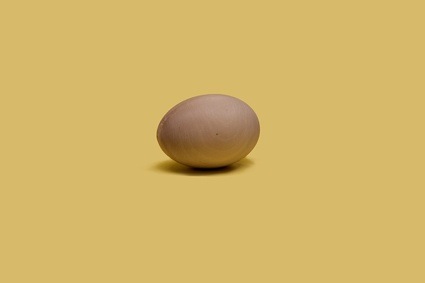 Renhui Zhao, A Guide to the Flora and Fauna of the World, Unbreakable egg
Renhui Zhao, A Guide to the Flora and Fauna of the World, Unbreakable egg
A company in Japan has developed a technique to create eggs that are so strong that they cannot be broken. The only way to access its contents is to puncture a hole in its shell with a pointed tool. The egg was created by adding the plant protein of a banyan tree to a chicken, thus creating an egg with a bark-like texture.
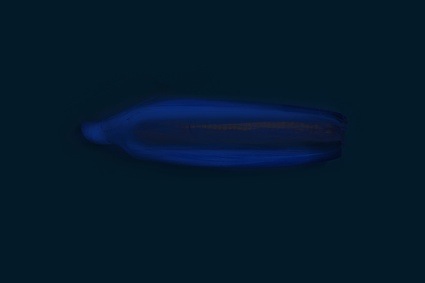 Renhui Zhao, A Guide to the Flora and Fauna of the World, Non-genetically modified Corn showing an aura
Renhui Zhao, A Guide to the Flora and Fauna of the World, Non-genetically modified Corn showing an aura
Corn is the number one crop grown in the United States and about 88% of it is genetically modified. Although there is little evidence that these crops pose a threat to humans, scientists are still understanding the effects of genetic engineering on corn. Scientists recently discovered non-genetically modified corn emit chemicals when they are being attacked by pests. These chemicals, which signal wasps to attack pests, are not present in genetically modified corn. Through Kirlian photography, the aura of a non-genetically modified corn can still be seen.
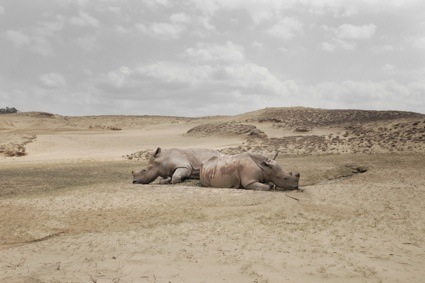 Renhui Zhao, A Guide to the Flora and Fauna of the World, rhinoceros with no horns, Grand Prix Fotofestiwal 2014
Renhui Zhao, A Guide to the Flora and Fauna of the World, rhinoceros with no horns, Grand Prix Fotofestiwal 2014
A small population of white rhinoceroses in Africa has evolved to have horns so small that they are barely visible. Experts believe this could be due to years of hunting individuals with large horns. The remaining rhinoceroses with smaller horns left to breed will eventually created a whole new hornless generation.
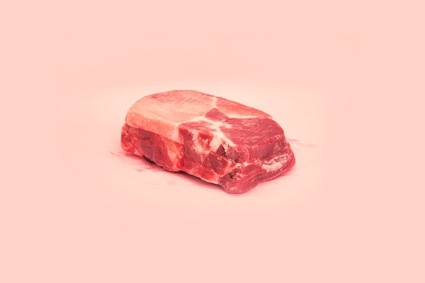 Fake beef, from the series A Guide to the Flora and Fauna of the World, 2013
Fake beef, from the series A Guide to the Flora and Fauna of the World, 2013
It has recently been found in China that pork has been made to aesthetically look like beef. ‘Beef colouring’ and ‘beef extracts’ were added to pork to make it look and taste like beef.
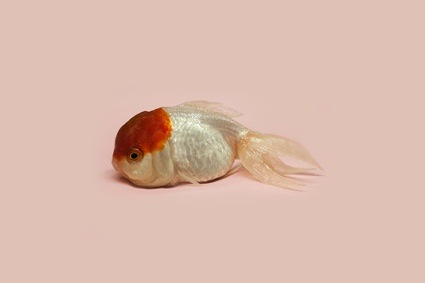 Renhui Zhao, A Guide to the Flora and Fauna of the World, World Goldfish Queen
Renhui Zhao, A Guide to the Flora and Fauna of the World, World Goldfish Queen
China organised the first International Goldfish Championships in Fuzhou in 2012. Over 3,000 goldfish from 14 countries competed for different titles including the World Goldfish Queen crown. Goldfish are judged by five criteria: breed, body shape, swimming gesture, colour and overall impression. The show stealer was a giant goldfish weighing around 4kg. The judges noted that not all goldfish can grow this big as factors such as breeding may affect size. Goldfish are bred out of generations of genetic mutations since the Jin Dynasty and their exact origins are unknown.
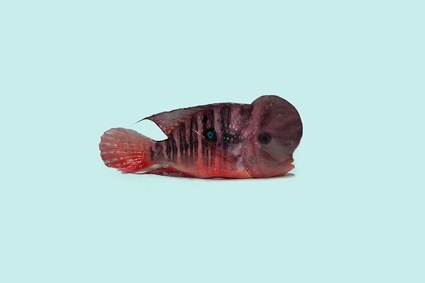 Renhui Zhao, A Guide to the Flora and Fauna of the World, Wild flowerhorn
Renhui Zhao, A Guide to the Flora and Fauna of the World, Wild flowerhorn
Flowerhorn cichlids are ornamental aquarium fish noted for their vivid colours and bulbous humped heads. A man-made hybrid, the flowerhorn was popular in Singapore in the late 1990s. When their popularity waned, owners released the fish into the local waters. Today, the fish thrive in large numbers in local reservoirs and waterways. Scientists have reported that the flowerhorn has taken on a different adaptation in recent years. The bulbous and round head it once had has given way to a sharp, flat and rounded disc. It is posited that the more streamlined form allows them to swim quickly away from predators.
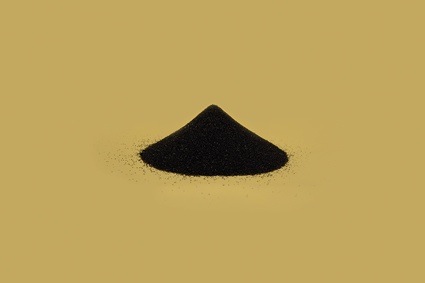 Renhui Zhao, A Guide to the Flora and Fauna of the World, Moon dust (ash belonging to 103 species of insects collected from a lamp cover)
Renhui Zhao, A Guide to the Flora and Fauna of the World, Moon dust (ash belonging to 103 species of insects collected from a lamp cover)
Less than 4% of Singapore exists in total darkness after 10pm. Insects are attracted to artificial light sources, though no one knows exactly why. The insects are usually killed by exhaustion or through contact with the heat from lamps. After being incinerated, their bodies become a heap of ash, collected in the covers of street lamps. The ash, also referred to as ‘moon dust’, is used by scientists to study the ecological impact of light pollution on insects.
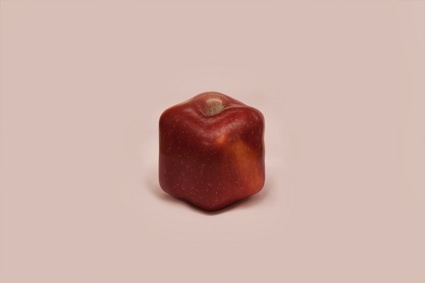 Renhui Zhao, A Guide to the Flora and Fauna of the World, square apple, Grand Prix Fotofestiwal 2014
Renhui Zhao, A Guide to the Flora and Fauna of the World, square apple, Grand Prix Fotofestiwal 2014
Sold in a department store in South Korea, these square apples were created as gifts for students taking the College Scholastic Ability Test, with some inscribed with the words ‘pass’ or ‘success’. A similar square watermelon was developed in Japan in the 1980s. The cubic fruits are created by stunting their growth in glass cubes.
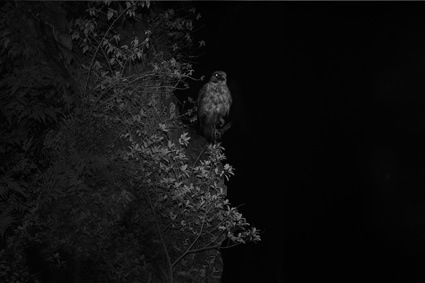 Renhui Zhao, A Guide to the Flora and Fauna of the World, Falcon that is an owl
Renhui Zhao, A Guide to the Flora and Fauna of the World, Falcon that is an owl
Falcons are diurnal birds but have recently adapted to become nocturnal, like owls. Urban falcons have begun to use artificial illumination from street lamps and lit buildings to hunt for bats throughout the night.
Photo on the homepage: Remote-controlled cockroach., from the series, A guide to the flora and fauna of the world. More at The Institute of Critical Zoologists.
The Grand Prix Fotofestiwal is on view at ART_INKUBATOR in Lodz until 15 June, 2014.
